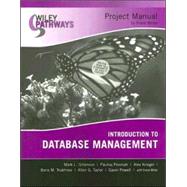
Note: Supplemental materials are not guaranteed with Rental or Used book purchases.
Purchase Benefits
What is included with this book?
Dr. Mark L. Gillenson has been practicing, researching, teaching, writing, and, most importantly, thinking, about data and database management for over twenty-five years, split between working for the IBM Corporation and being a professor in the academic world. While working for IBM, he designed databases for IBM's corporate headquarters, consulted on database issues for some of IBM's largest customers, taught database management at the prestigious IBM Systems Research Institute in New York, and conducted database seminars throughout the United States and on four continents. In one such seminar, he taught introduction to database to an IBM development group that went on to develop one of IBM's first relational database management system products, SQL/DS.
Frank Miller has nearly 30 years experience designing, developing, and delivering technical training materials. For 20 of those years, SQL language database management systems have been an area of special interest and expertise. During that time he has written books and other training materials that are used by various schools and professional organizations in the United States and around the world.
| Introducing to Data and Data Management | |
| Identifying Business Data | |
| Identifying Human Data Sources | |
| Installing SQL Server 2005 Evaluation Edition | |
| Learning About SQL Server Management Studio | |
| Identifying Key Management Areas | |
| Introducing Databases and Database Management Systems 2 | |
| Comparing Database Models | |
| Identifying DBMS Architecture and Components | |
| Reviewing Server Hardware Resources | |
| Investigating SQL Server Databases | |
| Identifying Application Requirements | |
| Data Modeling | |
| Understanding Data Modeling Concepts | |
| Recognizing Entities, Attributes, and Identifiers | |
| Recognizing Relationships | |
| Reading an ERD | |
| Creating an ERD | |
| Viewing Basic Database Objects | |
| Designing a Database 4 | |
| Recognizing Key Concepts | |
| Converting Relationships | |
| Reviewing a Normalized Database | |
| Recognizing Normalization Errors | |
| Normalizing Data | |
| Implementing a Database | |
| Understanding Terms and Concepts | |
| Identifying Solution Requirements | |
| Creating a Database | |
| Creating Tables, Part 1 | |
| Setting Table Constraints | |
| Creating Tables, Part 2 | |
| Understanding the SQL Language | |
| Understanding Terms and Concepts | |
| Investigating Help Resources | |
| Comparing Command Environments | |
| Using the SELECT Statement | |
| Using DDL Commands | |
| Using DML Commands | |
| Data Access and Manipulation | |
| Understanding Data Access | |
| Retrieving Data | |
| Using Advanced Data Retrieval | |
| Using Batches and Scripts | |
| Recognizing and Correcting Errors | |
| Improving Data Access | |
| Understanding Data Access | |
| Investigating Resources and Configuration Settings | |
| Monitoring Performance | |
| Recognizing Bottlenecks | |
| Using Views and Indexes | |
| Using Procedures and Functions | |
| Database Administration | |
| Understanding Administration | |
| Understanding Roles and Responsibilities | |
| Matching Lifecycle Requirements | |
| Resolving Administration Issues | |
| Managing "As-needed" and Periodic Tasks | |
| Transactions and Locking | |
| Understanding Transactions and Locking | |
| Understanding Transaction Types | |
| Understanding Transaction Isolation and Locking | |
| Using Transactions | |
| Monitoring Transactions and Clearing Blocked Transactions | |
| Data Access and Security | |
| Understanding Data Access and Security | |
| Designing for Security | |
| Understanding Your Security Environment | |
| Managing Security Principals | |
| Managing Permissions | |
| Managing Backups | |
| Supporting Database Applications | |
| Understanding Support Configurations | |
| Designing Data Environments | |
| Working in a Distributed Environment | |
| Using Distributed Queries | |
| Using Replication | |
| Understanding Data Issues | |
| Table of Contents provided by Publisher. All Rights Reserved. |
The New copy of this book will include any supplemental materials advertised. Please check the title of the book to determine if it should include any access cards, study guides, lab manuals, CDs, etc.
The Used, Rental and eBook copies of this book are not guaranteed to include any supplemental materials. Typically, only the book itself is included. This is true even if the title states it includes any access cards, study guides, lab manuals, CDs, etc.